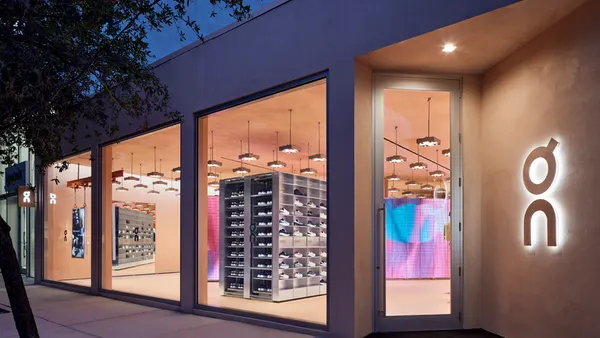Dive Brief:
-
Amazon on Thursday reported a 20% revenue jump in the second quarter to $63.4 billion, as overall net product sales rose 12.5% to $35.9 billion from $31.9 billion in the year-ago quarter. Net income rose to $2.6 billion, from $2.5 billion a year ago, according to a company press release.
-
In North America, sales rose to $38.7 billion from $32.2 billion a year ago, as operating expenses there surged to $37.1 billion from $30.3 billion a year ago. Operating income in the region fell 14.8% to $1.56 billion from $1.83 billion a year ago.
-
Online store sales rose to $31.1 billion from $27.2 billion a year ago. Physical store sales (mostly Whole Foods) were flat year over year, reaching $4.3 billion in the quarter. The company's revenue take from third party seller services rose 23% year over year to $11.9 billion from $9.7 billion a year ago.
Dive Insight:
Amazon on Thursday said that its move to speed up Prime delivery to one day is costing a bit more than the $800 million they'd predicted last quarter.
"That number's probably going to come out north of a billion dollars," Jon Reily, executive vice president of retail and e-commerce at Publicis Sapient, told Retail Dive in an interview, noting that not only did revenues rise 20%, but profit also rose significantly, even if it missed expectations.
The e-commerce giant is still expanding the assortment that's ready to be shipped so quickly, at home and abroad, according to Amazon CFO Brian Olsavsky. But the investment is paying off, he told analysts on a call. "We are really pleased with the customer response," he said, adding that one-day volume accelerated throughout the quarter, especially in North America. "We're in the middle of a journey here."
Olsavsky's contention that one-day shipping spiked sales is backed up by outside firms, including GlobalData. "Our data show that this has been popular, and Amazon has picked up some new Prime members as a result and has captured greater share of those shoppers seeking convenience or needing a product urgently," GlobalData Retail Managing Director Neil Saunders said in emailed comments. "In our view, neither of these constituencies is temporary so Amazon has effectively succeeded in boosting its long-term share of the market."
In fact, several analysts noted to Retail Dive that the quarter demonstrated a new level of strength in Amazon's retail operations, at a time when AWS cloud unit profits lagged behind analyst expectations.
"The retail side is pretty solid, it's a lot more solid, frankly, than it has been for a really long time," said Reily, who previously spent 15 years at Amazon. "For a long time, AWS was writing the checks. They're investing in the long tail — they don't care about quarter to quarter, they're working decade to decade. There's a thing at Amazon called 'the peculiar way' — never sacrifice a long term goal for short term gain, and this is a perfect example of that. They're perfectly willing to spend a billion-ish dollars, and they're racing to do that."
Olsavsky acknowledged that the outlay to speed up its fulfillment "does create a shock to the system," and said the company expects "to be working through it through the next few quarters."
"But when the dust settles, we will regain our cost efficiency over time," he said.
Olsavsky also made it clear that the speedier delivery is meant to compete with the brick-and-mortar advantage held by rivals. "It strengthens your purchase decision, it strengthens your need not to go elsewhere," he said. "That's what we're seeing in North America."
And that is indeed putting pressure on rivals, particularly Walmart.
"Walmart is on the defensive," Reily said, even more so than Target, though both players have become assertive in e-commerce. "Target still wants to drive people to the store. Ultimately they want you in the store, so it's a different long-term strategy."
But it's a defensive play on Amazon's part, too, according to Saunders. "As uncomfortable as offering one-day delivery might be, we would argue that the competitive dynamics in the market have compelled Amazon to make this move," he said. "Traditional retailers like Walmart and Target are ramping up their e-commerce efforts and have the advantage of being able to offer collection from stores for shoppers wanting to obtain products quickly. By and large, Amazon has no such benefit, so it had to neutralize it by offering faster shipping for free."
Amazon's expense sheet was bloated not just by its one-day shipping project, but also by hiring and investment at AWS and by marketing. Its marketing expense for the quarter rose 48% to $4.3 billion, more than 20% higher than the next highest expense, according to an Edge by Ascential report emailed to Retail Dive. It reached 6.7% of net sales, more than the 5.9% for all of its fiscal year 2018 and significantly more than Walmart's 0.6% spend for fiscal 2019 and Target's 2% in 2018, the report found.
The company has a slew of new products to promote at the moment, but for its overall Prime Day advertising alone it ponied up some $8.1 million on TV ads and $5.9 billion on digital advertising, according to Publicis Sapient, citing Business Insider and Kantar Research. But those digital display numbers likely don't include Amazon's own network on their own devices, like video ads on FireTV or Kindle. "So, at market value that number is probably significantly higher," Reily said.
While Amazon may be strengthening its retail chops, the company needs to spring for more investment in retail's most old-fashioned marketing tool — physical stores, according to Saunders.
"Although some progress is being made, we maintain our view that a more radical approach is needed," he said of Whole Foods. "Physical stores are key to Amazon's future and getting the Whole Foods division on a growth trajectory is a key part of unlocking the potential of the whole group."














